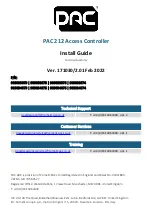
source (even after the proper source selection). The PLLCR will be zeroed out and the device will automatically
clear the MCLKSTS bit and switch back INTOSC1.
1.3.2.4 PLL-based Clock Module
This device has two PLL modules. “PLL” refers to the main PLL that generats the clock for the core and all
peripherals. PLL2 refers to the PLL that generates the clock for the USB and HRCAP modules.
shows the OSC and PLL block diagram.
PLLSTS[OSCOFF]
OSCCLK
PLL
VCOCLK
4-bit Multiplier PLLCR[DIV]
OSCCLK or
VCOCLK
CLKIN
OSCCLK
0
PLLSTS[PLLOFF]
n
n
≠
0
PLLSTS[DIVSEL]
/1
/2
/4
To
CPU
Figure 1-23. OSC and PLL Block
The following is applicable for devices that have X1/X2 pins:
When using XCLKIN as the external clock source, you must tie X1 low and leave X2 disconnected.
Table 1-23. Possible PLL Configuration Modes
PLL Mode
Remarks
CLKIN and
PLL Off
Invoked by the user setting the PLLOFF bit in the PLLSTS register. The
PLL block is disabled in this mode. The CPU clock (CLKIN) can then be
derived directly from any one of the following sources: INTOSC1, INTOSC2,
XCLKIN pin, or X1/X2 pins. This can be useful to reduce system noise and
for low power operation. The PLLCR register must first be set to 0x0000 (PLL
Bypass) before entering this mode.
0, 1
2
3
OSCCLK/4
OSCCLK/2
OSCCLK/1
PLL Bypass
PLL Bypass is the default PLL configuration upon power-up or after an
external reset ( XRS). This mode is selected when the PLLCR register is set
to 0x0000 or while the PLL locks to a new frequency after the PLLCR register
has been modified. In this mode, the PLL itself is bypassed but the PLL is not
turned off.
0, 1
2
3
OSCCLK/4
OSCCLK/2
OSCCLK/1
PLL Enabled Achieved by writing a non-zero value n into the PLLCR register. Upon writing
to the PLLCR, the device will switch to PLL Bypass mode until the PLL locks.
0, 1
2
3
OSCCLK*n/4
OSCCLK*n/2
OSCCLK*n/1
(1)
PLLSTS[DIVSEL] must be 0 before writing to the PLLCR and should be changed only after PLLSTS[PLLLOCKS] = 1. See
.
(2)
The input clock and PLLCR[DIV] bits should be chosen in such a way that the output frequency of the PLL (VCOCLK) is a minimum of
50 MHz.
1.3.2.4.1 PLL Control Registers
The PLLCR register is used to change the PLL multiplier of the device. Before writing to the PLLCR register, the
following requirements must be met:
• The PLLSTS[DIVSEL] bit must be 0 (CLKIN divide by 4 enabled). Change PLLSTS[DIVSEL] only after the
PLL has completed locking, that is, after PLLSTS[PLLLOCKS] = 1.
Once the PLL is stable and has locked at the new specified frequency, the PLL switches CLKIN to the new value
as shown in
. When this happens, the PLLLOCKS bit in the PLLSTS register is set, indicating that
the PLL has finished locking and the device is now running at the new frequency. User software can monitor the
PLLLOCKS bit to determine when the PLL has completed locking. Once PLLSTS[PLLLOCKS] = 1, DIVSEL can
be changed.
any time you are writing to the PLLCR register.
System Control and Interrupts
76
TMS320x2806x Microcontrollers
SPRUH18I – JANUARY 2011 – REVISED JUNE 2022
Copyright © 2022 Texas Instruments Incorporated
Содержание TMS320 2806 Series
Страница 2: ......
















































